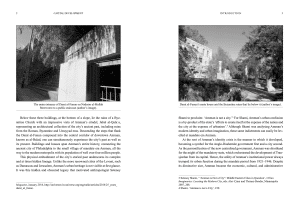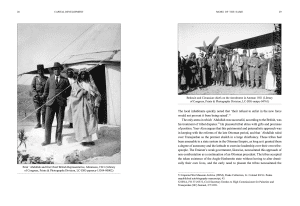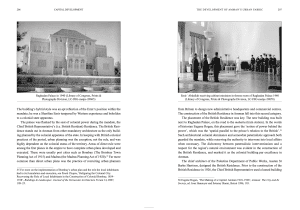Working to improve mutual understanding between the Middle East and the West
Working to improve mutual understanding between the Middle East and the West
No products in the basket.
Amman, the capital of Jordan, contends with a crisis of identity rooted in how it grew to become a symbol for the Anglo-Hashemite government first, and a city second. As a representation of the new centralised authority, Amman became the seat of the government that orchestrated the development of Transjordan with the institution of the British mandate in 1921. Despite its diminutive size, the city grew to house all the components necessary for a thriving and cohesive state by the end of the mandate in 1946. Regardless of its modernising and regulatory ambitions, however, the mandatory government did not control all facets of life in the region. Instead, the story of Transjordan is one of tensions between the state and the realities of the region, and the limitations that forced the government to scale down its aspirations. This book presents the history of Amman’s development under the rule of the British mandate from 1921–1946 and explores how the growth of the Anglo-Hashemite state imbued the city with physical, political, and symbolic significance.
Harrison B. Guthorn is a Strategic Leader at EAB in Washington, DC, specialising in public and private institutions. He completed his PhD at the University of Maryland, College Park, in 2015. He was a 2013–2014 Fulbright IIE Fellow in Amman, and was awarded both a University of Maryland Dean’s Fellowship and Dissertation Fellowship for his research. In addition to various research roles, he has worked as a Lecturer of Modern Middle East History at the University of Virginia and the University of Maryland.
Interview with Fulbrighter Dr. Harrison Guthorn on his latest book
Acknowledgements
List of Figures
List of Acronyms and Abbreviations
Introduction
of the Mandate
Imperial Funds, Private Capital and Local Actors
Demonstrations in Faisal Square
Conclusion
Appendix I: Legislative Councils of Transjordan (1929–1946) Appendix II: Amman Residential Architecture Matrix
Bibliography
Index
Introduction
Shami to proclaim: ‘Amman is not a city.’3 For Shami, Amman’s urban confusion is a by-product of the state’s ‘efforts to create itself at the expense of the nation and the city at the expense of urbanism’.4 Although Shami was analysing Amman’s modern identity and urban imagination, these same indictments can easily be levelled at mandate era Amman.
At the root of Amman’s identity crisis is the manner in which it developed, becoming a symbol for the Anglo-Hashemite government first and a city second. As the personification of the new centralised government, Amman was shorthand for the might of the mandatory state, which orchestrated the development of Transjordan from its capital. Hence, the utility of Amman’s institutional power always trumped its urban function during the mandate period from 1921–1946. Despite its diminutive size, Amman became the economic, cultural, and administrative
centre of Transjordan, and housed all the integral components of a successful and cohesive centralised and bureaucratised state by the end of the British Mandate in 1946. Even so, in spite of its modernising and controlling ambitions, the government did not control all facets of life in Transjordan. Instead, the story of mandatory Transjordan is a story of tension between the aspirations of the state and its reality. It is a story that privileged government utility and security above everything else. Fiscal, bureaucratic, and societal limitations checked nearly every government action or goal, and while such confines did not prevent the government from functioning successfully, they did force it to scale down its aspirations. Regardless of these constraints, the growth of the Anglo-Hashemite state imbued Amman with physical, political, and symbolic significance, and the city’s expansion forced the inhabitants of Transjordan to adapt to a new structure of power. As a result, the history of Amman during the British Mandate acts as a mirror for all of Transjordan.
The British Transjordan Mandate intended to create a centralised state based in a city where one had not existed for millennia. Although the history of Amman stretches back to biblical references (to the Ammonites) and it was an important Roman and Umayyad site, it was not even recognised as a settlement in the Ottoman cadastral survey of 1586.5 Transjordan appeared as a blank spot on the map of the Middle East for the Ottoman Empire and the Great Powers of Europe in the early nineteenth century. The extent of Ottoman involvement in the region was the provision of minimal protection for the hajj route. The only large settlements of the time were Salt, Maʿan and Karak. Vast swathes of Bedouin- controlled territory surrounded each of these settlements and held sway over the towns. The Bani Sakhr tribe were dominant in Salt, while Maʿan was split between tribes who owed allegiance to Damascus or the Hijaz. Karak was under the sway of the non-Bedouin al-Majalis.6 It is important to remember that there was no ‘Ottoman Transjordan’. Ottoman officials only recognised the region by districts, not administrative units: ʿAjlun, al-Balqaʾ, al-Karak and Maʿan. Of these regions, the only one that formally acknowledged Ottoman authority was Jabal ʿAjlun, whose largely settled non-Bedouin population regularly paid taxes to Damascus.7
In 1878, the Ottoman Refugee Commission directed a group of Circassians to repopulate the largely abandoned area in order to re-establish it as part of the Ottoman Empire. This Ottoman resettlement policy was a means to alleviate a shortage of manpower throughout the empire, as well as an attempt to increase the number of lawful Muslims in the region. Provincial Ottoman officials often prohibited immigrants from the Caucasus, most of whom were rural people in any case, from settling in cities. Instead, immigrants established new villages on unoccupied land. In the Balqa region of Jordan, the Circassians formed settlements in Amman, Wadi Seer, Sweileh, Jerash, Naour, and Rusaifa.8 Amman grew from fifty families in 1878 to a town with a population of 1,000 people in 1893, and reached a population of nearly 5,000 in 1914.9 However, it is important to remember that despite its early development Amman still paled in comparison to the established Ottoman centre of Salt.
Even after the resettlement, by 1921 Amman had fewer than 5,000 inhabitants. The creation in the Levant of a capital city that owed no fealty to another regional power was a novel development. The centralisation project undertaken by the mandatory state caused the cultural and political hybridisation of the local population. The city developed as a hybridised amalgam of Ottoman, Arab and British characteristics evident in the expansion of state programmes, urban infrastructure, and local cultural practices. This development always unfolded as a slurry of lofty goals and compromises. Despite British antipathy towards the Ottoman Empire and their lasting imprint on Transjordan, the mandatory state could not erase their legacy. Contrary to the narrative of the Hashemite state, the Transjordan government heavily relied on Ottoman structures and institutions already in place at the time of its founding. Only towards the end of the mandate period did the Transjordanian state begin to move beyond this largely Ottoman framework. Amman’s composite identity is a by-product of a government that could not afford to start with a blank slate. Indeed, the mandatory government and Amman both built upon a foundation of monarchical order, borrowed elites, and colonial negotiation. Very few things in Amman were not a personification of the tension, duality, and limitations inherent in the state itself.
From its inception, the British Mandate of Transjordan was a reflection of British imperial policy and the realities of the empire writ large. The empire needed to protect the homeland, and the colonial holdings, in turn, needed to be able to support the metropole. This security imperative necessitated close colonial administration.10 Nevertheless, a lack of resources and strained budgets always limited the scope of imperial oversight.11 Although an important facet of the geopolitical stability of the British Empire, mandate Transjordan never garnered more than a paltry budget and a handful of British administrators, with the fiscal economy constantly limiting the aspirations of the Anglo-Hashemite state.
At all times during the Transjordan Mandate, the power of the state was divided between the monarch and the colonial overseers. These two poles of authority controlled the development of Transjordan’s institutions and jockeyed for influence over its future.12 Furthermore, the social force of the populace of Transjordan checked and balanced monarchical and colonial agents throughout the mandate. These three, at times competing, forces shaped the development of Jordanian governance and the enduring legacy of the Anglo-Hashemite state. Thus, the Transjordanian regime evolved in Amman, gradually incorporating disparate influences while silencing dissonant actors. As such, the entire city of Amman was a realm of patronage and governance, with the government constantly negotiating with its elite populace through a combination of co-option, persuasion, and punishment. The creation of the Hashemite Kingdom of Jordan was also the culmination of Emir ʿAbdullah’s monarchical machinations throughout the mandate period, and while Transjordan may have started as a weak tribally oriented monarchy, it evolved into a modern state through the efforts of ʿAbdullah, the British, and the elites and notables of Transjordan.
This shift of patrimonial authority from the hinterland to a new capital city allows for the study of the city’s urban development in comparison to other Middle Eastern cities during the interwar period. Amman’s urban evolution poses a number of similarities and common characteristics to other regional centres such as Ankara, Beirut, Jerusalem and Damascus. With the exception of Ankara, an enduring Ottoman urban heritage can be found in all of these urban spaces. Unfortunately, comparisons to other new capital cities outside the region, such as Brasilia and Washington, D.C., are not as fruitful because Amman never benefited from an urban plan.13 Unlike most purpose-built capital cities, which were planned meticulously, Amman was left to develop without government plans, stipulations or limitations. The choice not to shape the cityscape in Amman was a discrete decision undertaken by the mandatory state. Transjordan’s governmental authority did not rely on the geography and architecture of Amman; instead, it relied on the young government’s institutional authority. Unlike Washington, D.C. or Brasilia, Amman could not afford to awe its inhabitants through magnificent construction projects. While the city was symbolically important to the state, its physical reality was not. Focusing on urban change in Amman, facilitated by its institutional and infrastructural centrality, provides an excellent opportunity to highlight the importance of locality and transnational political and cultural forces in the development of the Modern Middle East. The city changes the vantage point from which we can understand the evolution of governance in Transjordan. By looking from the inside out, this study evaluates both British administrators and Transjordanian administrators alike in their ability to create the new Transjordanian state.
1 Mohammad al-Asad and Bill Lyons, eds., Old Houses of Jordan: Amman 1920–1950, Amman 1997, 84. The house was built by Nimr ʿAbdullah al-Humud by 1920, but the exact construction date is unknown. The Arabisation of the army in 1956 was a result of King Hussein’s expulsion of Glubb and all other British officers from the country and the subsequent transitioning of the army to Arab leadership.
2 Pat Binder and Gerhard Haupt, ‘25 Years of Darat al Funun in Amman’, Nafas Art
3 Seteney Shami, ‘“Amman is Not a City”: Middle Eastern Cities in Question’, Urban Imaginaries: Locating the Modern City, eds. Alev Çinar and Thomas Bender, Minneapolis 2007, 208.
4 Shami, ‘Amman is not a City’, 230.
5 Alastair Northedge, ‘The History of Ammān in the Early Islamic Period’, Studies on Roman and Islamic ‘Ammān: The excavations of Mrs C-M Bennett and Other Investigations, Volume 1: History, Site and Architecture, ed. Alastair Northedge, New York 1992, 47–55. For more on pre-modern Amman, see Alastair Northedge, ed., Studies on Roman and Islamic ‘Ammān: The excavations of Mrs C-M Bennett and Other Investigations, Volume 1: History, Site and Architecture, New York 1992; Christa Paula, David Saunders and Ammar Khammash, Jordan: A Timeless Land, London 2005.
6 Eugene Rogan, Frontiers of the State in the Late Ottoman Empire: Transjordan, 1850–1921, Cambridge 1999, 27–34.
7 Rogan, Frontiers of the State, 21–6.
8 Seteney Shami, ‘Historical Processes of Identity Formation: Displacement, Settlement, and Self-Representations of Circassians in Jordan’, Iran and the Caucasus 13, 2009, 144–9.
9 Jane Hacker, Modern ‘Amman: A Social Study, Durham 1960, 59.
10 David Fromkin, A Peace to End All Peace: Creating the Modern Middle East 1914–1922, New York 1989, 558–63. Fromkin argues that the British rationale for entering the Middle East quickly changed. By 1922, British society generally rejected both the idealistic (advancing civilisation) and practical (that it benefited Britain to extend the empire) arguments for imperialism. The British public only acquiesced to British involvement in the Middle East because Winston Churchill convinced them that it would be an inexpensive imperial venture that would safeguard other British interests.
11 Timothy J. Paris, ‘British Middle East Policy-Making after the First World War: The Lawrentian and Wilsonian Schools’, The Historical Journal 41, 1998, 773–93. For more on evolving British policy during the interwar period, see Michael J. Cohen and Martin Kolinsky, eds., Britain and the Middle East in the 1930s: Security Problems, 1935–1939, New York 1992; Zach Levey and Elie Podeh, eds., Britain and the Middle East: From Imperial Power to Junior Partner, Portland 2008.
12 The early foundational works on Transjordan include Mary C. Wilson, King Abdullah, Britain and the Making of Jordan, Cambridge 1989; P.J. Vatikiotis, Politics and the Military in Jordan: A Study of the Arab Legion 1921–1957, New York 1967; Uriel Dann, Studies in the History of Transjordan, 1920–1949, Boulder 1984. These works largely focus on the development of the Jordanian military and the relationship between ʿAbdullah and the British. Recent works on Transjordan have begun to move away from this elite-centric interpretation of Jordanian history and tend to be more thematically organised.
13 James Holston, The Modernist City: An Anthropological Critique of Brasilia, Chicago 1989; Frederick Gutheim, Worthy of a Nation: The History of Planning for the National Capital, Washington, D.C. 1977. Washington, D.C. is primarily the product of two urban plans, the 1791 Pierre L’Enfant plan and the McMillan Commission and its 1901–1902 recommendations. The construction of Brasilia became the central goal of President Jusecelino Kubitschek (1956–1961), who wanted to create a new national space and a new national epoch by linking Brazil’s interior to its coast. Brasilia serves as a case study of the modernist city as proposed in the manifestos of the International Congress of Modern Architects (CIAM), and embodies the premise of social transformation via modern architecture and planning to create new forms of collective association. In both cities, you cannot divorce the development of their urban fabric from the urban planning that created it.



‘With his book, Harrison Guthorn offers a fresh angle from which to explore the mandate years in Transjordan. He carefully and in great detail reconstructs the process through which the capital Amman became the focal point of the new political entity. His book is both an institutional history of Jordan and a good case study to examine the British colonial rule and official mind. It thus offers a valuable contribution to the historiography of Jordan, as well as to the surging literature on the League of Nations and the mandate system.’
–Yoav Alon, author of The Shaykh of Shaykhs: Mithqal al-Fayiz and Tribal Leadership in Modern Jordan
‘As the product of a considerable amount of deep research into archival and secondary source materials, Capital Development makes a compelling argument about the centrality of Amman’s growth to Jordan’s history, both a city and a political capital. It constitutes a most welcome addition to the literature on Jordan as well as that on cities and urbanization in the modern Arab world.’
–Michael R. Fischbach, author of State, Society, and Land in Jordan
Our work relies on the generous support of our donors. Any contribution, no matter how small, helps us achieve our aims.